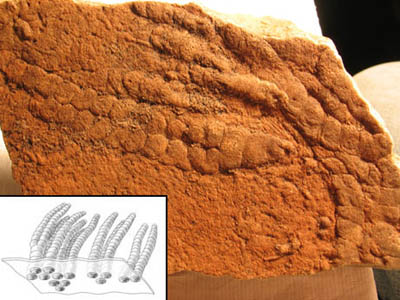 |
| Sir David Attenborough and Charnia masoni. |
When watching documentaries about a subject I am fond of I have a bad habit of trying to predict what they are about to say, so when I come away having learnt a few things I love it. This is often true of Attenborough documentaries, which he narrates over stunning visuals which keep us gripped. I am pleased to say that I learnt a few things. I have not yet got to grips with how the Ediacaran forms relate to each other temporally, which this documentary did well, introducing the fractal and frondose forms first, ghost-like in appearance and living in the deep sea (they say quite confidently what colour they might have been, which bugged me a little). I didn't even know just how big Charnia could grow, as I was more familiar with the classic Charnwood forest example. It was also mentioned that the fractal form of Fractofusus used only 6 to 8 genetic commands, something I would love to know more about.
 |
| Fractofusus from Mistaken Point. |
Before the documentary was shown in full I watched a few clips on Youtube, one of which intrigued me rather a lot and made me quite sceptical. Mary Droser was shown discussing Funisia, a fossil which she claims as the first providing evidence of sexual reproduction. The clip showed that the evidence for this were clusters of traces which varied little in size, showing that they were of the same age. At first I couldn't figure out why this would indicate sexual reproduction, so it was fortunate that the documentary showed why. Corals reproduce in the same way, occasionally asexually, but then sometimes sending out large amounts of sperm and eggs to found new colonies, all of which would be the same age, just like the Funisia found. See here for a little more.
 |
| Funisia fossils and a reconstruction. |
The next really fascinating bit showed the research of Phil Donoghue from the University of Bristol, using an enormous synchrotron to look at fossil embryos. Using the powerful technology he is able to see the developing organism inside the egg sac, even after half a billion years. The reconstructions show that the worm inside had teeth at the front and a gut running right through the middle. This thing was both complex and predatory. Early embryos are yet another area I really need to look into, perhaps I could pester him in Bristol when I go next week.....
Overall the documentary is well worth watching; as ever the visuals are great, the reconstructions are not amazing but are quite fascinating, the insight is excellent and the fossils are beautifully filmed. Although I disagree with some aspects I know that is inevitable when it comes to Ediacarans and I learnt a lot from this, giving me new areas to research. If you missed it, then BBC iPlayer is your new best friend.


3 comments:
Glad to see one person picking up some of the problems with this programme. Don't get me wrong - I love most of DA's work - got all the DVD sets, met him (charming guy). BUT I was irritated all the way through this. Frond-like Ediacarans as bilaterians? I don't think so. Sexual reproduction as a spark for animal multicellarity? Does not explain why was it around for a billion+ years beforehand (there are many better explanations). Sponges as simple colonies of cells? (Bernie won't have been happy with that). Five kingdoms of life as five main branches of the tree? Come off it - what century was this written in? And where was any insight into the RNA world, endosymbiosis, molecular biology? Oh, I could carry on. Poor and inconsistent scientific editing I think. Very disappointing.
Thanks for this nice overview. If you don't already know it and want some more info on these very weird Ediacarans try:
Fedonkin, et al., 2007. The Rise of Animals. Evolution and Diversification of the Kingdom Animalia. Johns Hopkins Uni Press
and
Trusler, et al., 2010. The Artist and the Scientists. Bringing Prehistory to Life. Cambridge University Press.
and
www.geosci.monash.edu.au/precsite
Best
Pat
Please see this on my YouTube:
http://www.youtube.com/watch?v=wlwigXTjEZc&feature=autoplay&list=FLqxVtwvWLtLo&index=4&playnext=3
Post a Comment